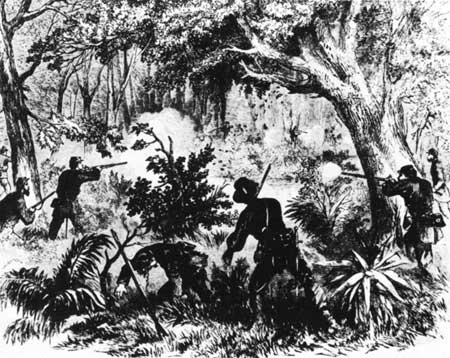|
VICKSBURG National Military Park |
 |

Skirmishing in the heavily wooded and flooded bottom lands during
the bayou expeditions.
From a wartime sketch
The Bayou Expeditions:
Grant Moves Against Vicksburg— and Fails (continued)
THE STEELE'S BAYOU EXPEDITION. The last and most extraordinary of Grant's unsuccessful attempts to reach Vicksburg was the Steele's Bayou expedition through 200 miles of narrow, twisting bayous north of Vicksburg. Like the Yazoo Pass operation, it was an effort to turn the city's right flank. This shorter route had been originally scouted in order to send aid to the Yazoo Pass expedition when that column seemed in great danger of being cut off and captured. Further exploration suggested the route to the bluffs by way of Steele's Bayou might prove the best of all possible approaches to Vicksburg, and Porter himself commanded the squadron of 11 vessels which entered Steele's Bayou from the Yazoo River on March 16.
The route was heavily obstructed by natural hazards, but Porter, warned by apprehensive officers who feared that superstructures would be carried away in crashing through the closely overhung waterways, answered with the declaration, "All I need is an engine, guns, and a hull to float them." Progress was slow through winding streams barely wide enough to admit passage of the gunboats. This time alert Confederates, aided by treacherous obstructions in the mouth of the Rolling Fork, nearly succeeded in shutting up and capturing the entire fleet by felling huge trees across the bayou to block Porter's retreat.
Sherman, following behind the fleet with infantry, received word of Porter's danger, and an eerie night march ensued. By the flaring light of candles held in the muzzles of their rifles, the Federal soldiers splashed through the canebrake hip deep in water and arrived in time to drive off the Confederates who had moved in behind the Union fleet. Three days were required to back the fleet to safety on the Mississippi, which was reached late in March. Grant had now tested all possible approaches to Vicksburg as he attempted to swing wide around its flanks to the north and south. Every effort had failed. In April, the Union Army was no closer to Vicksburg than it had been in December. The Southern bastion on the Mississippi had successfully withstood Union land and naval attacks for almost a year.

|
|
Last Modified: Mon, Dec 2 2002 10:00:00 am PDT |


